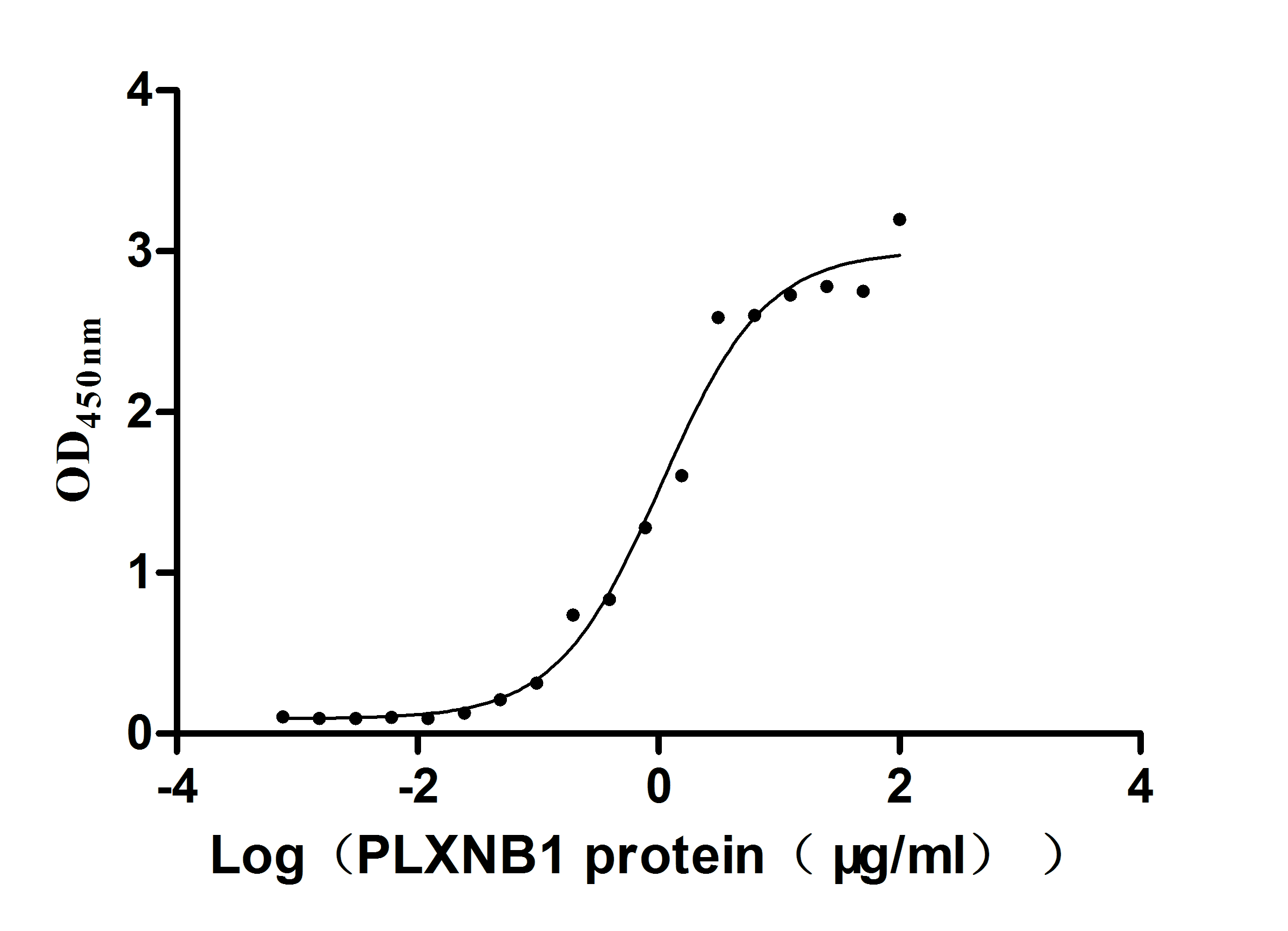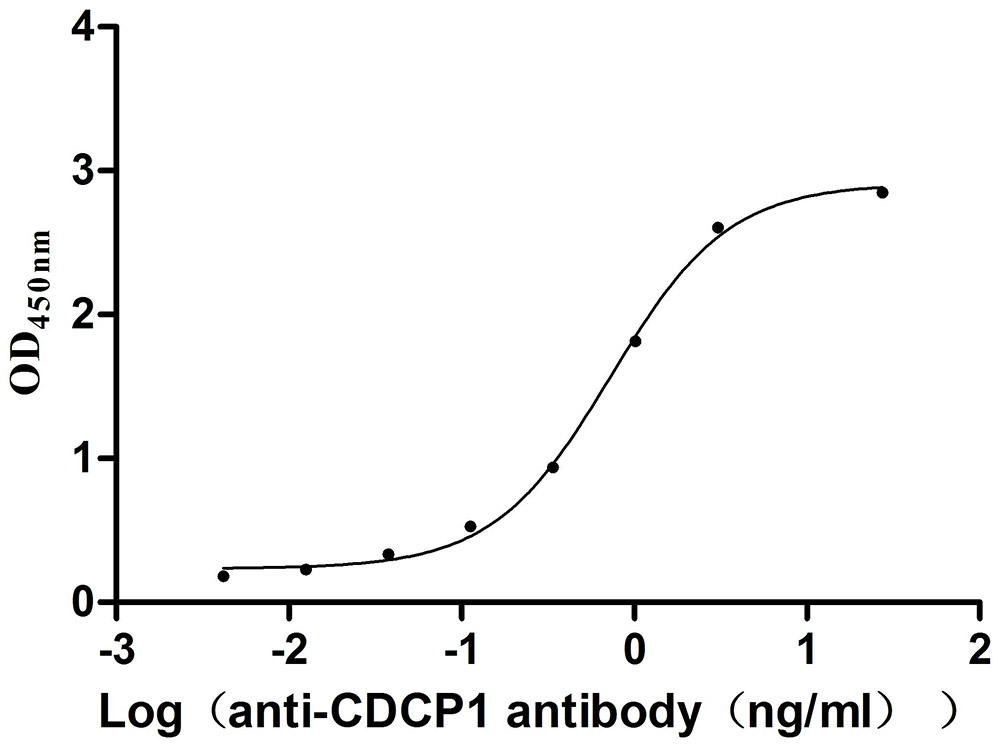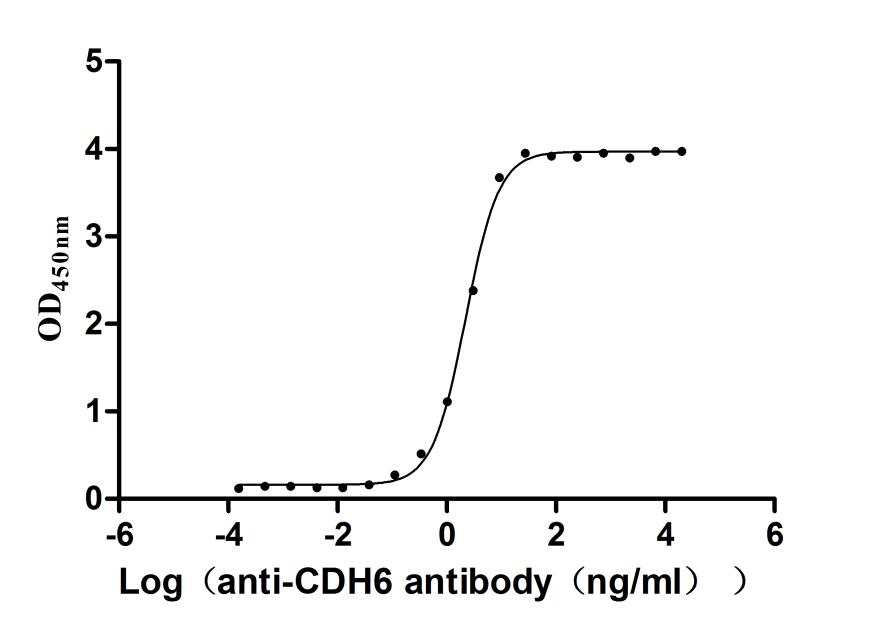Recombinant Human Programmed cell death protein 5 (PDCD5)
-
货号:CSB-YP017671HU
-
规格:
-
来源:Yeast
-
其他:
-
货号:CSB-EP017671HU-B
-
规格:
-
来源:E.coli
-
共轭:Avi-tag Biotinylated
E. coli biotin ligase (BirA) is highly specific in covalently attaching biotin to the 15 amino acid AviTag peptide. This recombinant protein was biotinylated in vivo by AviTag-BirA technology, which method is BriA catalyzes amide linkage between the biotin and the specific lysine of the AviTag.
-
其他:
-
货号:CSB-BP017671HU
-
规格:
-
来源:Baculovirus
-
其他:
-
货号:CSB-MP017671HU
-
规格:
-
来源:Mammalian cell
-
其他:
产品详情
-
纯度:>85% (SDS-PAGE)
-
基因名:PDCD5
-
Uniprot No.:
-
别名:PDCD5; PDCD5_HUMAN; Programmed cell death protein 5; Protein TFAR19; TF 1 cell apoptosis related protein 19; TF-1 cell apoptosis-related protein 19; TFAR19; TFAR19 novel apoptosis-related
-
种属:Homo sapiens (Human)
-
蛋白长度:Full Length of Mature Protein
-
表达区域:2-125
-
氨基酸序列ADEELEALR RQRLAELQAK HGDPGDAAQQ EAKHREAEMR NSILAQVLDQ SARARLSNLA LVKPEKTKAV ENYLIQMARY GQLSEKVSEQ GLIEILKKVS QQTEKTTTVK FNRRKVMDSD EDDDY
-
蛋白标签:Tag type will be determined during the manufacturing process.
The tag type will be determined during production process. If you have specified tag type, please tell us and we will develop the specified tag preferentially. -
产品提供形式:Lyophilized powder
Note: We will preferentially ship the format that we have in stock, however, if you have any special requirement for the format, please remark your requirement when placing the order, we will prepare according to your demand. -
复溶:We recommend that this vial be briefly centrifuged prior to opening to bring the contents to the bottom. Please reconstitute protein in deionized sterile water to a concentration of 0.1-1.0 mg/mL.We recommend to add 5-50% of glycerol (final concentration) and aliquot for long-term storage at -20℃/-80℃. Our default final concentration of glycerol is 50%. Customers could use it as reference.
-
储存条件:Store at -20°C/-80°C upon receipt, aliquoting is necessary for mutiple use. Avoid repeated freeze-thaw cycles.
-
保质期:The shelf life is related to many factors, storage state, buffer ingredients, storage temperature and the stability of the protein itself.
Generally, the shelf life of liquid form is 6 months at -20°C/-80°C. The shelf life of lyophilized form is 12 months at -20°C/-80°C. -
货期:Delivery time may differ from different purchasing way or location, please kindly consult your local distributors for specific delivery time.Note: All of our proteins are default shipped with normal blue ice packs, if you request to ship with dry ice, please communicate with us in advance and extra fees will be charged.
-
注意事项:Repeated freezing and thawing is not recommended. Store working aliquots at 4°C for up to one week.
-
Datasheet :Please contact us to get it.
相关产品
靶点详情
-
功能:May function in the process of apoptosis.
-
基因功能参考文献:
- Collectively, these data demonstrate that PPEF-1 plays a pivotal role in tumorigenesis of lung cancer cells by reducing PDCD5-mediated genotoxic stress responses. PMID: 28051100
- In the high malignant group the PDCD4 mRNA and PDCD5 mRNA expressions were significantly decreased compared with the low malignant group and the control group. PDCD4 mRNA and PDCD5 mRNA expressions are promising targets for the diagnosis and treatment of glioma. PMID: 29921407
- serum PDCD5 levels reflect endothelial NO production and are correlated with diabetes mellitus, high-density lipoprotein cholesterol, and coronary calcium PMID: 29588416
- As a transcriptional activator, PITX1 regulates apoptosis-related genes, including PDCD5, during gastric carcinogenesis. PMID: 29734189
- DKK-1 and PDCD5 can be independent predictors of overall survival in patients suffering from chondrosarcoma. PMID: 27255549
- Endogenous PDCD5 overexpression accelerated multiple myeloma cell apoptosis under dexamethasone treatment. PMID: 26617773
- Studies indicate that programmed cell death 5 (PDCD5) interacts with the tumor protein p53 (p53) pathway to promote cell apoptosis. PMID: 26433055
- This review describes what is known about PDCD5 and its cellular functions. [review] PMID: 26775586
- The results suggest a role of PDCD5 in the regulation of p53 function but unrelated to cell cycle arrest or apoptosis, at least in the cell types investigated. PMID: 26062895
- PDCD5 selectively mediates HDAC3 dissociation from p53, which induces HDAC3 cleavage and ubiquitin-dependent proteasomal degradation. This is a a mechanism for p53 activation via PDCD5-dependent HDAC3 decay under genotoxic stress conditions. PMID: 26077467
- PDCD5 expression is negatively correlated with disease progression and stage in ovarian cancer. PMID: 25881604
- These findings uncovered an apoptotic signaling cascade linking YAF2, PDCD5, and TP53 during genotoxic stress responses. PMID: 25603536
- Transgenic mice with systemic overexpression of human PDCD5 were protected from cardiac remodeling. PMID: 25881505
- Findings have uncovered an apoptotic signaling cascade linking PDCD5, OTUD5, and p53 during genotoxic stress responses. PMID: 25499082
- s identified DNAJB1 as a negative regulator of PDCD5-mediated apoptosis and found that the apoptosis network of PDCD5 regulates cancer cell death. PMID: 25444898
- We confirmed that PDCD5 overexpression stimulated the promoter activities of KLF9 by luciferase reporter assays. PMID: 24173774
- PDCD5 is necessary and sufficient for NF-kappaB p65 mediated apoptosis PMID: 24343129
- The expression of PDCD5 and its protein were shown to be reduced in laryngeal squamous cell carcinoma. The functional importance of PDCD5 as a regulating agent in cell apoptosis suggests that it may play a key role in tumour pathogenesis and development. PMID: 24265335
- PDCD5 bound the apical domain of the CCTbeta subunit, projecting above the folding cavity without entering it. Like PDCD5, beta-tubulin also interacts with the CCTbeta apical domain, but a second site is found at the sensor loop deep within the folding cavity. PMID: 24375412
- PDCD5 could be considered as a reliable marker of favorable prognosis of HCC patients PMID: 23807738
- PDCD5 may contribute to maintain a basal pool of p53 proteins in unstressed conditions, but upon DNA damage it functions as a co-activator of p53 to regulate transcription and cell cycle arrest. PMID: 22914926
- Insulin-like growth factor 1 down-regulates programmed cell death 5 in osteoarthritis chondrocytes. PMID: 23322062
- Data indicate that the expressions of genes PDCD5 and TIMP2 were consistent with their DNA methylation profiles. PMID: 23369618
- a correlation between increased levels of PDCD5 in serum and liver disease progression and indicate the potential utility of serum PDCD5 as a biomarker for monitoring liver injury. PMID: 23656249
- Transgenic PDCD5 plays an antitumor role with increased expression, suppressing skin cancer development. PMID: 23688867
- Plasma and synovial fluid PDCD5 expression levels are inversely associated with TNF-alpha and disease activity in patients with rheumatoid arthritis. PMID: 23327497
- results suggest that PDCD5 expression plays a significant role in the malignant progression of human gastrointestinal stromal tumors and may be a key inhibitory factor PMID: 22965478
- PDCD5 participates in the inflammatory process of asthmatic airway. Its abnormal expression may be associated with the uncontrolled state of asthmatics. PMID: 22883196
- PDCD5 promotes chemosensitivity by activating the mitochondria-related apoptotic pathway. PMID: 22688731
- This study is the first providing evidence that PDCD5 plays an important role in cardiac remodeling. PMID: 22253891
- the PDCD5 binding site on p53 is localized within residues 41-56 of p53 TAD2 subdomain while p53 binds preferentially to the positively charged surface region around the C-terminals of helices alpha3 and alpha5 and the N-terminal of helix alpha4 of PDCD5 PMID: 22372375
- The effect of recombinant human PDCD5 was also investigated and shown to sensitize cells to DNA damage by promoting caspase-3 activity. PMID: 22261045
- Abnormal expression of pdcd5 may be involved in the pathogenesis of multiple myeloma. PMID: 20561417
- Lost or reduced PDCD5 expression may contribute to the pathogenesis of human serous cystadenocarcinomas. PMID: 21165576
- Downregulated expression of programmed cell death 5 is associated with chondrosarcoma. PMID: 20872801
- Data show that the number of apoptotic cells in renal tubuli with lupus nephritis correlated negatively with the intensity of PDCD5 expression. PMID: 16083554
- Overexpression of PDCD5 could enhance apoptosis of rheumatoid arthritis fibroblast-like synoviocytes induced by triptolide. PMID: 19088824
- protein overexpression enhance apoptosis in triptolide-induced synoviocytes of rheumatoid arthritis patients PMID: 20047520
- By downregulating apoptosis, low PDCD5 expression may play an important role in the occurrence and development of PAROSTATIC NEOPLASM. PMID: 20120772
- PDCDS was highly expressed in some ragged red fibers in patients with limb-girdle type mitochondrial myopathy and chronic progressive external ophthalmoplegia. PMID: 19957502
- Results imply that the PDCD5 gene may be a target gene under the control of some important apoptosis-related transcriptional factors during the cell apoptosis. PMID: 15033527
- The effects of the secondary structure of PDCD5 on its tertiary structure and function are reported. PMID: 16083422
- -27G/-11A SNP is associated with reduced PDCD5 promoter activity and increased susceptibility to chronic myelogenous leukemia. PMID: 16361542
- Could play an important role in regulation of apoptotic processes in gastric cancer cells and gastric tumors. PMID: 16547588
- PDCD5 may be involved in the pathogenesis of rheumatoid arthritis. PMID: 17468978
- PDCD5 expression in bone marrow nucleated cells in untreated acute myeloid leukemia patients is lower than in normal controls. PMID: 17605845
- exogenous PDCD5 expression enhances the chemosensitivity of K562 leukemia cells to either low or high doses of idarubicin in vitro, resulting in increased apoptosis. PMID: 18401719
- Reduced expression of PDCD5 is associated with high-grade astrocytic gliomas PMID: 18695908
- PDCD5 contributes to maintaining a basal pool of Tip60 and its HAT activity PMID: 19308289
- Studies of structure-function relationship of PDCD5 by multidimensional NMR methods and flow cytometer and fluorescence microscopey. PMID: 19358820
显示更多
收起更多
-
蛋白家族:PDCD5 family
-
组织特异性:Widely expressed. Highest levels in heart, testis, kidney, pituitary gland, adrenal gland and placenta.
-
数据库链接:
HGNC: 8764
OMIM: 604583
KEGG: hsa:9141
STRING: 9606.ENSP00000466214
UniGene: Hs.443831
Most popular with customers
-
Recombinant Human Plexin-B1 (PLXNB1), partial (Active)
Express system: Mammalian cell
Species: Homo sapiens (Human)
-
Recombinant Human Nectin-4 (NECTIN4), partial (Active)
Express system: Mammalian cell
Species: Homo sapiens (Human)
-
Recombinant Macaca mulatta Semaphorin-4D isoform 1 (SEMA4D), partial (Active)
Express system: Mammalian cell
Species: Macaca mulatta (Rhesus macaque)
-
Express system: Mammalian cell
Species: Macaca fascicularis (Crab-eating macaque) (Cynomolgus monkey)
-
Recombinant Mouse CUB domain-containing protein 1 (Cdcp1), partial (Active)
Express system: Mammalian cell
Species: Mus musculus (Mouse)
-
Recombinant Human Myosin regulatory light chain 12B(MYL12B) (Active)
Express system: E.coli
Species: Homo sapiens (Human)
-
Recombinant Macaca fascicularis Cadherin 6(CDH6),partial (Active)
Express system: Mammalian cell
Species: Macaca fascicularis (Crab-eating macaque) (Cynomolgus monkey)
-
Recombinant Human C-C chemokine receptor type 5 (CCR5)-VLPs (Active)
Express system: Mammalian cell
Species: Homo sapiens (Human)




















